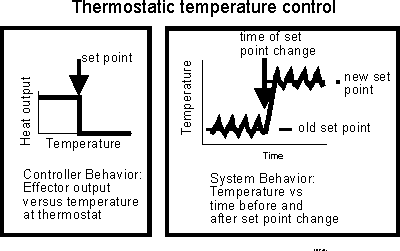 <>
<>
Thermostatic temperature control systems consist of a thermostat plus some sort of heater and/or cooler. The thermostat is a thermally actuated switch that changes between the "on" and "off" state at a specific temperature, usually adjustable. They have unequivocal set points -- the temperature at which the switch is activated. In their simplest form, the heater "effector" is on, whenever the temperature of the medium in which the thermostat is immersed is below the set point. If equipped with an effector for cooling, it is on whenever temperature is above the set point. Effector activity, measured for example by heater power, is not graded, i.e., when the effector is activated it is on full blast.
Temperature control systems like this always oscillate. On the right is an example. If temperature is below the set point, the heater is on and the temperature rises. When the rising temperature passes the set point, the thermostat switches the heater off and temperature falls passively. Eventually, it falls below the set point and the cycle repeats.
If you have to analyze a system like this experimentally, you could look at the average level of the oscillation and pretty closely approximate the set point level. If the set point changes, you can accurately estimate the change in set point from the change in average levels.
The fact is that, even in a system a simple as this, you can get in some difficulty. for example, temperature continues to increase for awhile after the heater shuts off. Finally, if the thermal load on the system changes, the mean level of the oscillatory temperature will change and you would be fooled if you identify the change in mean temperature as a change in set point.
Click for next page , for the first of the series on Proportional temperature controllers or Return to index page